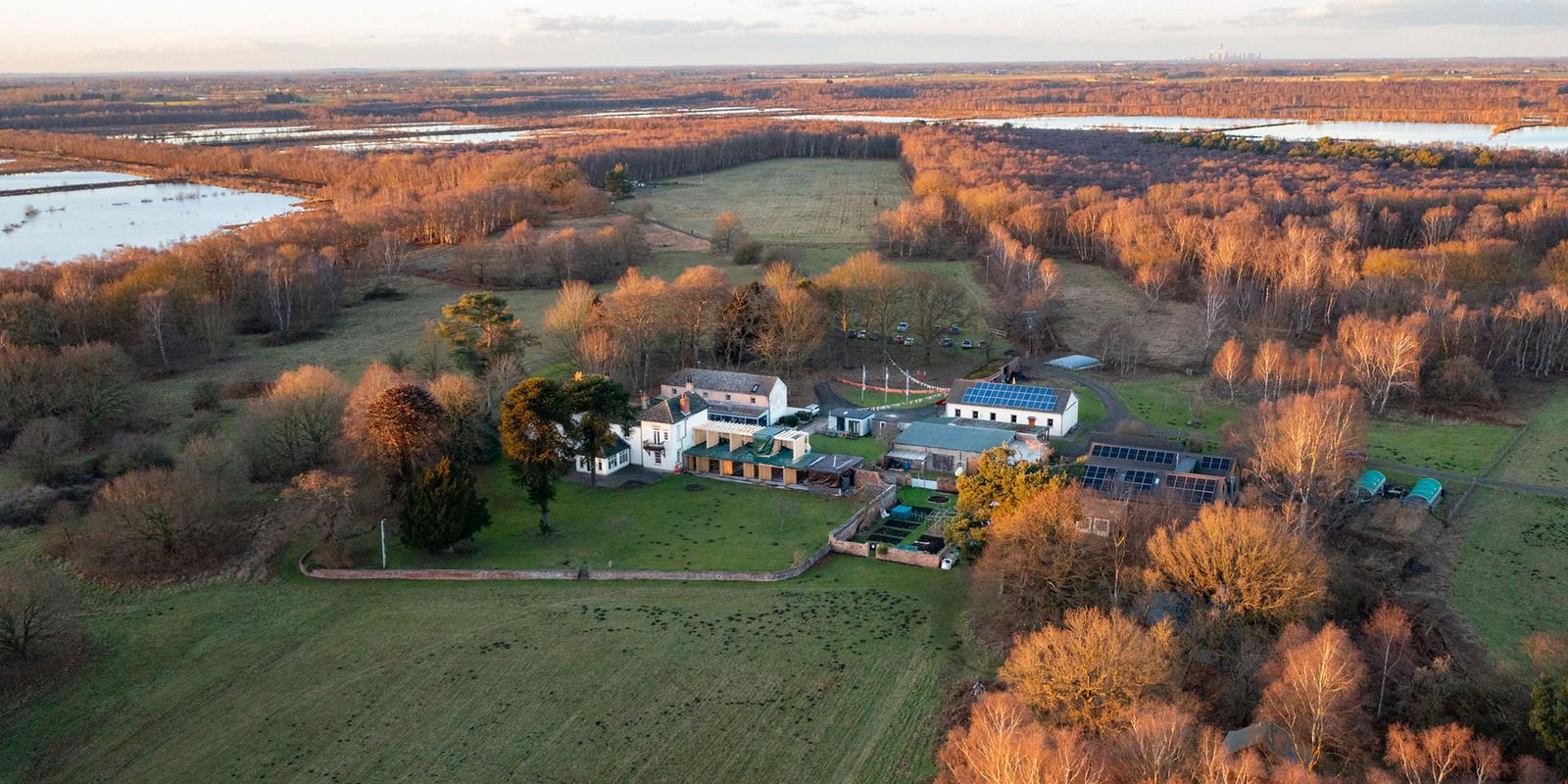NATURE & SURROUNDINGSLindholme Estate: A Rare & Precious Habitat
Lindholme Hall estate sits on a sand and gravel island formed during the last ice age at the base of historic Lake Humber. Surrounded by Hatfield Moor in the Humberhead Levels National Nature Reserve, it is one of Britain’s few remaining continental raised mires and among Europe’s largest ecological reclamation areas. Home to rare, diverse and often endangered species, the peatland is undergoing large-scale restoration thanks to dedicated conservation efforts.

The peatlands of Hatfield Moor are a rare and ancient landscape—home to unique ecosystems, a living record of history, and a vital resource in the fight against climate change. Their preservation is our responsibility and their restoration, our hope. Environment
Lindholme ‘Island’
Lindholme Hall Estate lies atop a rare calcareous ridge within the Humberhead Levels, surrounded by the vast Hatfield Moors. This 180-acre site appears as a mosaic of grassland, hayfields, and regenerating wood pasture, edged with ancient pollarded oaks, birch, and scattered pines—remnants of a landscape over 7,000 years in the making. Historically accessible only in winter via frozen moor paths or by boat, and now connected to the nearest village, by a three-mile single track road, the estate remains a striking ecological ‘island’ in one of England’s most significant lowland peatland areas.At the north of the estate lies Jack’s Piece—a 60-acre remnant of intact lowland raised mire (bogs) spared from commercial peat extraction. It now acts as a refugium for rare species and a vital donor site for surrounding peatland restoration. The area supports wetland flora such as sphagnum mosses, heather, and cotton grasses, and provides habitat for species like curlew, snipe, and the Mire Pill Beetle (Curimopsis nigrita), a nationally rare invertebrate found only in the Thorne and Hatfield Moors.
Together, the estate and its surroundings represent a vital refuge for biodiversity and a key site in the long-term ecological restoration of this remarkable landscape.
Hatfield Moors and Peatlands

The peatlands surrounding Lindholme Hall are lowland raised mires (bogs) as rare as any patch of the amazonian rainforest and an environmentally essential resource.
These mires are among the last of their kind in Britain and are recognised as:
● Sites of Special Scientific Interest (SSSI).
● European Special Protection Areas (SPA).
● Wetlands of International Importance under the Ramsar Convention.
● Special Area of Conservation (SAC)
LIVING HISTORY
Hatfield Moor forms part of the wider Humberhead Peatlands, a vast and ancient wetland system that acts as a natural time capsule, preserving thousands of years of history. Their waterlogged, oxygen-poor conditions inhibit decay, locking away traces of early human activity as well as plant life.● Neolithic artefacts revealing early human habitation.
● A 4,500-year-old wooden trackway, one of only four found in Europe.
● Remnants of Bronze Age tree stumps preserved by the peat, offering a window into a world long past.
ENVIRONMENTAL SIGNIFICANCE
Peatlands remove and store carbon from the atmosphere. Storing almost four times as much as UK forests, peatlands are a vital natural resource in the fight against climate change. Despite their ecological and environmental value peatlands have been dismissed over centuries as wastelands and systematically degraded for commercial use with alarming consequences for the habitat and the environment.BIODIVERSITY
The mires’ acidic, wetland environment provides an essential habitat for an exceptional invertebrate community, reinforcing the moors’ ecological importance.“Hatfield Moor and its neighboring Thorne Moor are among Britain’s most significant sites for rare insect species.”
Combined, the moors host over 5,500 species, including 30 Red Data Book species and more than 250 nationally scarce species.Conservation and Regenerations at Gomde UK

HABITAT PROTECTION
In addition to our peatland restoration efforts, our volunteer team also cares for other traditional habitats across the estate—including heathland, acidic grassland, ancient orchards, and woodlands. A recent example of our wider conservation work is the completion of the Veteran Oak Survey, funded by the Isle of Axholme and Hatfield Chase Landscape Partnership. The survey identified essential conservation measures to protect the estate’s ancient and veteran oaks, some of which are centuries old. This holistic approach is a vital part of the estate’s living history and biodiversity.BROADENING OUR IMPACT
Through the Lindholme Old Moor Management Group (LOMM Group), we work alongside local scientists to safeguard and regenerate both the island’s rarest habitat and the wider Humberhead Peatlands.Our efforts include:
● Propagating native mosses: the foundation of healthy peatlands.
● Enhancing biodiversity: Supporting the recovery of fragile and rare ecosystems
● Combating climate change: Regenerating peatlands to function as natural carbon sinks, mitigating climate impacts.
We work to create a flourishing habitat, to enhance biodiversity and combat climate change.
Discover Our Conservation Initiatives
The Future of Lindholme Hall Estate
At Gomde UK, the work of preserving nature goes hand in hand with the practice of the Buddha’s teachings on peace, loving-kindness, and wisdom — honouring traditions of the past to address challenges of today. The estate offers a space where spiritual reflection and environmental action intersect, inspiring visitors to connect deeply with both themselves and the world around them.From the unique geological history of Lindholme Estate to the urgent conservation of its surrounding peatlands, this sanctuary stands as a testament to resilience, renewal, and the power of compassion in action.
Together, we can ensure that this fragile landscape continues to thrive for generations to come.
Discover Lindholme's Heritage
Like to be involved? We’d love to hear from you.
Join Us
